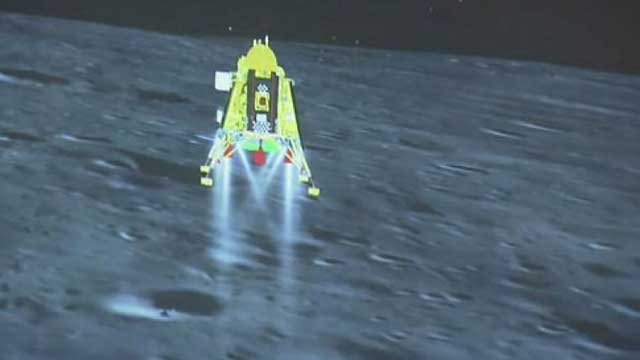India has landed a spacecraft on the moon, as the country – the fourth to achieve a moon landing – cements its growing prowess in space and technology.
The Indian spacecraft Chandrayaan-3 landed on Wednesday on the moon’s south pole, an uncharted territory that scientists believe could hold vital reserves of frozen water and precious elements.
The mission is seen as crucial to lunar exploration and confirming India’s standing as a space power, and came just days after a similar Russian lander crashed.
“India is on the moon,” said S Somanath, chief of the Indian Space Research Organisation (ISRO) as the spacecraft landed.
A successful moon mission would dovetail with Prime Minister Narendra Modi’s image of an ascendant India asserting its place among the global elite and would help bolster his popularity in advance of a crucial general election next year.
“This is a victory cry of a new India,” said Modi, who was seen waving the Indian flag as he watched the landing from South Africa, where he is attending the BRICS summit.
Scientists and officials clapped, cheered and hugged each other as the spacecraft landed, with the government now looking to spur investment in private space launches and related satellite-based businesses.
The latest mission came with a price tag of $74.6m – far lower than those of other countries, and a testament to India’s frugal space engineering.
This was India’s second attempt to land a spacecraft on the moon and came less than a week after Russia’s Luna-25 mission failed. People across the country were glued to television screens and said prayers as the spacecraft approached the surface.
Chandrayaan means “moon vehicle” in Hindi and Sanskrit. In 2019, ISRO’s Chandrayaan-2 mission successfully deployed an orbiter but its lander crashed.
“In general, it’s very difficult to land on the south part of the moon. Most vehicles have landed in the equator region of the moon, where the characteristics of the moon are much easier to deal with,” Christopher Conselice, professor of extragalactic astronomy at the University of Manchester, told Al Jazeera.
“It’s a very historic day, and I really look forward to the science we’re going to see come out of the [mission]. I think it will be quite interesting, and I hope it encourages other missions to do similar things around the moon,” he said.
The Chandrayaan-3 is expected to remain functional for two weeks, running a series of experiments, including a spectrometer analysis of the mineral composition of the lunar surface.
Its landing on the moon was “very important” for India, as it helped demonstrate its “technological advancement”, according to Carla Filotico, a consultant at SpaceTec Partners.
“It is important for scientific exploration as it is landing on the [moon’s] south pole and it will allow India to explore the water and ice on the moon,” Filotico said.
“[It will help in] accumulating data on science and geology of the moon and gathering information on exploration of the solar system’s history and evolution.”
‘Impressive’
Congratulatory messages poured in from around the world following the successful landing.
The US Department of State’s Bureau of Oceans and International Environmental and Scientific Affairs said Chandrayaan-3 success will “power” the future.
“Your success will power the imagination and light the future of people around the world,” the department posted on X, formerly known as Twitter.
Meanwhile, Russian President Vladimir Putin congratulated India for an “impressive” achievement.
“This is a big step forward in space exploration and, of course, a testament to the impressive progress made by India in the field of science and technology,” the Kremlin statement read.
Numerous countries and private companies have been racing to successfully land a spacecraft on the lunar surface.
Japan plans to launch a lunar lander to the moon over the weekend as part of an X-ray telescope mission, and two US companies have also been vying to put landers on the moon by the end of the year, one of them at the south pole.
In the coming years, NASA plans to land astronauts at the lunar south pole.-Al Jazeera and news agencies





